|
|
Advertisement:
|
|
Intel's MatrixRAID Examined |
|
Join the community - in the OCAU Forums!
|
Performance Continued, HDD Failure, Conclusions
The PCMark 2004 "Hard Disk Test Suite" comprises 4 tests with a total of 11 subtests: The "Windows XP Start-up" test measures disk activities occurring at system start-up. The "File Copying" test contains disk activities from copying around 400 MB of files. The "Application Loading" test measures loading times for MS Word, Acrobate Reader, MS Media Player, Mozilla Internet Browser and 3DMark 2001. The "General Hard Disk Usage" test contains disk activities from using common applications like opening a text document, playing MP3 files and browsing the Internet.
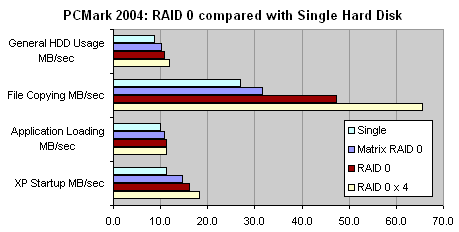
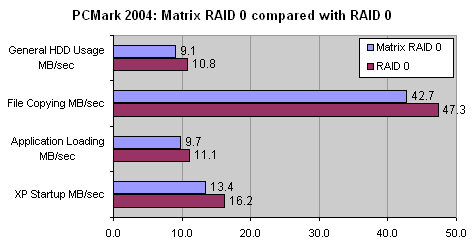
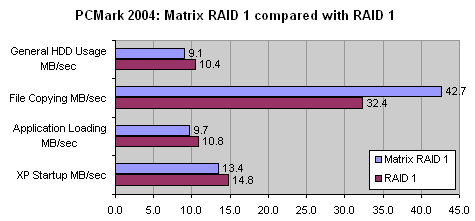
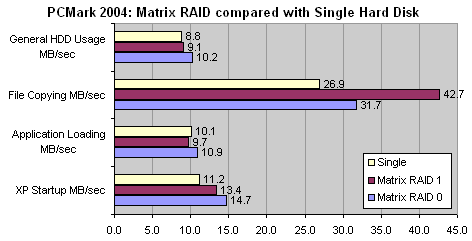
The test results with the broader and more contemporary PCMark 2004 show a similar trend as W99 with a few details being different: MatrixRAID 0 seems to be around 10% slower than RAID 0. But it is still 30% faster at loading applications, starting Windows and copying files than a single disk. RAID 0x4 performance is again dwarfing all other RAID scenarios. MatrixRAID 1 is around 5% slower than RAID 1 with the exception of file copying, where it seems almost 30% faster. In all PCMark 2004 tests, apart from application loading, MatrixRAID 1 is still faster than a single disk. *In fact, even when copying files it manages to outrun a single disk configuration.
WHAT HAPPENS IN CASE OF A HARD DISK FAILURE?
RAID 1 provides data redundancy by mirroring all data from one disk on the other disk in the array. If one disk fails, the mirror kicks in and provides a 100% up-to-date backup of the failed hard disk. That sounds good in theory, but how does this work in reality? In order to simulate a hard disk failure we disconnected one of the two hard disks of our MatrixRAID volume while Windows XP was running. In case of single disk usage the operating system and all data would become immediately inaccessible. The same happens when the OS and applications are installed on a RAID 0 array. The very second one hard disk in a RAID 0 array fails, the system freezes, is not accessible anymore and cannot be revived. This exactly happened, as expected, with our MatrixRAID 0 array. The partition we formatted on the RAID 0 array simply vanished. RAID 0 is cutting files into small chunks and spreading them across the hard disks in the array. Consequently they cannot be reconstructed when a disk in the array is missing, even when the missing or failed disk is replaced with a new one. That exactly was the reason why we did not install Windows XP, vital applications, and important data on the RAID 0 array, placing them instead on the RAID 1 array. Because of the RAID 1 redundancy function Windows XP and all applications continued to operate as if nothing had happened. All data and programs were fully accessible evem though we had unplugged one of the MatrixRAID disks.
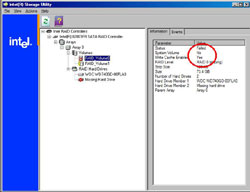 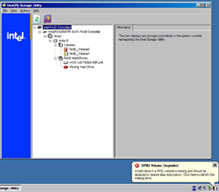
If the user has installed Intelís "Application Accelerator RAID Edition", they will receive a warning, at the moment a disk fails, telling them the RAID 0 array has "failed" and that the RAID 1 array has been "degraded". This means that although the system is operating normally and all data on the RAID 1 array is safe, data redundancy is no longer provided. The user now has two options: they can continue to operate the system with one hard disk and without data redundancy, or they can rebuild the RAID 1 array to restore data redundancy. This can be done while Windows is running by "hot plugging" a fresh hard disk into the socket of the failed disk. With the help of the IAA, the RAID 1 array is then rebuilt.
 
In our case it took almost 30 minutes to rebuild the RAID 1 array from the remaining source disk with around 40 GB data. After rebuilding is completed, the IAA informs the user that "RAID 1 integrity is restored" and full data redundancy is again provided.
An even more convenient scenario requires that a third disk has already been allocated as a "spare" member of the RAID 1 array. Such a spare disk is dormant and without any function until one of the RAID 1 member disks fails. If this happens then entire rebuilding process runs automatically. When a member disk of the RAID 1 array fails, the IAA issues a warning and then starts rebuilding the RAID 1 array with the assigned spare hard disk without user intervention. We have tested rebuilding a RAID 1 array with a spare disk using both RAID 1 hard disks as source and found that the rebuilding process is "fail-safe". Such a RAID 1 array with a ready spare disk provides a very high level of data security. Only in the extremely unlikely case that both hard disks in the RAID 1 array die at the same time would the data be lost.
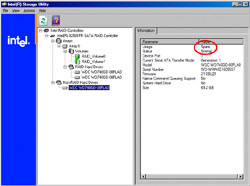 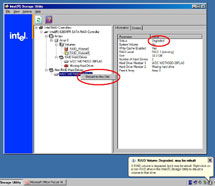
SUMMARY AND CONCLUSION
There has been some controversy recently about the benefit of RAID 0. Some sources claim that RAID 0 is basically useless because the alleged speed impact does not exist for desktop applications. Other sources come to a different conclusion using exactly the same benchmarks. Our own tests have consistently shown that RAID 0 at least in standard benchmarks can improve HDD performance. The fact is - and RAID 0 users know this by own experience - that Windows XP and applications are loading faster with RAID 0. On the other hand everybody who understands the concept of RAID 0 knows that only read and write intensive applications can benefit from it. Games for example do therefore certainly not run faster if they are installed on a RAID 0 array. In their "MatrixRAID Manual" (page 13) Intel carefully avoids sensational claims about RAID 0 performance: "Real world usage models where RAID 0 can be of particular benefit include loading large files in a video editing application or creating CD or DVD images."
However, the benefits of running MatrixRAID are obvious. Although the speed benefit of RAID 0 in general might be much smaller than commonly expected, it does no harm either. It does speed up application loading time and it can improve hard disk performance when working with large files. The benefit of RAID 1 is beyond doubt. Itís not only providing a constant, automated data back-up, but keeps the system fully operational in case of an otherwise catastrophic hard disk failure. The combination of both RAID levels in one PC is not new, but until now it required a minimum of four physical hard disks. With Intelís MatrixRAID itís now possible to experience the benefits of both RAID 0 and RAID 1 with only two hard disks and this of course cuts the cost in half. Performance wise we found no difference between MatrixRAID 0 and a single RAID 0 array. MatrixRAID 1 was slightly slower than single RAID 1. Additional features we liked with MatrixRAID are hot-plugging, the option to assign a RAID 1 spare disk for automatic array rebuilding, the possibility to migrate an existing OS partition into a RAID 0 array and the "Application Accelerator RAID Edition" software for arranging, monitoring and rebuilding an array. The only shortcoming we found is that MatrixRAID currently does not allow you to arrange a RAID array with more than 2 hard disks. But this will disappoint only a very few hardcore RAID enthusiasts. In summary we think that Intel's MatrixRAID is an affordable, easy to use and certainly beneficial feature for many desktop users.
For more info:
MatrixRAID Performance Brief here.
MatrixRAID FAQ here.
MatrixRAID User Manual here.
|
|
Advertisement:
All original content copyright James Rolfe.
All rights reserved. No reproduction allowed without written permission.
Interested in advertising on OCAU? Contact us for info.
|

|


